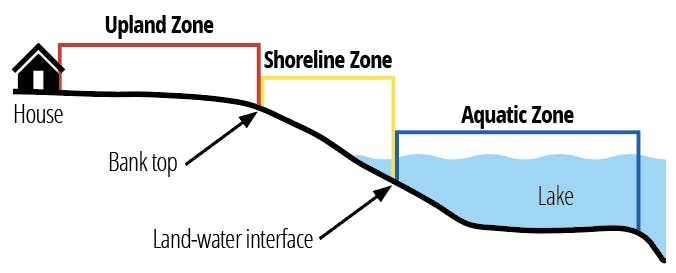Aquatic Plants
The District’s aquatic plant program is designed to boost native plant populations by controlling invasive plants, such as Eurasian Watermilfoil and Curlyleaf Pondweed.
Aquatic plants play an integral role in a lake ecosystem by:
- providing habitat throughout the life cycles of fish and other aquatic organisms
- supporting aquatic life by oxygenating water through photosynthesis
- serving as food for both terrestrial and aquatic organisms
- reducing shoreline erosion from wave action caused by wind and boats.
- stabilizing lake bottom sediments so they don’t release nutrients that cause algal blooms
- and much more!
The removal of large areas of aquatic vegetation may impact lake health in several ways. Reduced water clarity, increased wind mixing of bottom sediments, more frequent algal blooms, and increased shoreline erosion are all potential impacts. The scale of aquatic plant removal determines how much the fish population is impacted. Large scale plant removals have the potential to reduce fish growth rates, foraging ability, survival, and the total number and diversity of fish that can be supported by a lake.
The non-permitted removal of aquatic plants such as water lilies may be reported to RPBCWD, city water resources staff, or the Minnesota DNR. While watershed district or city staff may help investigate a report, the DNR is the agency responsible for enforcement action related to the destruction of aquatic plants.
RPBCWD boosts native aquatic plant populations by controlling invasive aquatic plants. As the removal of aquatic plants is restricted by the DNR, RPBCWD must apply for a permit to control invasives and stay below maximum allowable treatment size. Read more about control of invasive aquatic plants.
Think Before You Remove
Are you thinking about removing aquatic vegetation along your shoreline? First consider if it's really necessary for lake access. If it's not needed for lake access, what are you trying to achieve by removing aquatic plants? Keep in mind that a lake is not a swimming pool but a complex ecosystem where aquatic plants are essential for lake health. Removing aquatic plants may result in unintended consequences such as:
- shoreline erosion
- invasion of non-native aquatic plants
- increased presence of geese and ducks in your yard
- decreased fishery
- decline in water quality
Next, do research to see if you need a permit to remove aquatic plants. The DNR Aquatic Plant Management page will help you determine this. Also check out the DNR's information about aquatic plant types and permits.
Click here to view the aquatic plant protection summary or click the image below.
Shoreland Vegetation
In addition to aquatic plants, the vegetation along and near the shoreline has a profound effect on lake health. The DNR Score-the-Shore program provides an overall shoreland health score for multiple lakes. The District has taken this a step further with their own version called the Shoreland Health Evaluation, rpbcwd.org/shoreland-health, which allows lake residents to look up the shoreland score for their individual property. The District grant program offers financial support to lake residents interested in improving their shoreland health scores.






